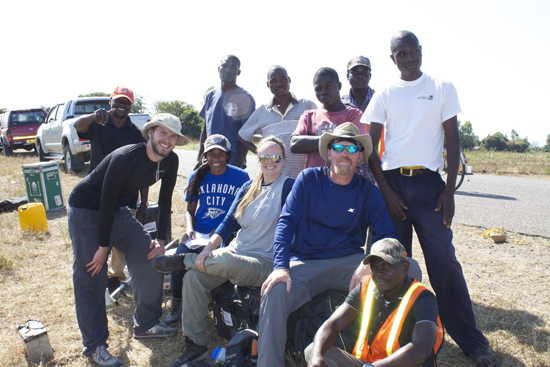Four Oklahoma State University geology students traveled to Malawi in Africa to study tectonic rifts last summer thanks to a 2014 grant from the National Science Foundation.
Dr. Estella Atekwana, geology department head, and Dr. Daniel Laó-Dávila, a geology professor, took four students to Karonga, Malawi, to explore the East African Rift that extends for thousands of miles along the continent’s edge bounded by the Indian Ocean.
“People don’t know what rifts are,” Atekwana said. “There used to be one big continent, called Pangea; it’s because of rifts that the continents broke apart. Malawi has a young rift system and is the go-to place to study the entire rift process.”
The grant allowed the Boone Pickens School of Geology to create an international program for its students, sending a total of 12 students in groups of four for three years. The trips allow the students to collect geological data and gain cultural experience outside of the university.
“The last thing I was expecting was a culture shock,” said Sam Dawson, a graduate student from Davidson, North Carolina. “Seeing what life was like in a developing country was eye-opening. The people are so happy. I saw some kids playing with simple toys for hours on end.”
Other students included undergraduates Tiara Johnson, from Midwest City, Oklahoma; Bryan Clappe, from Chelsea, Oklahoma; and Courtney Hall, from Broken Arrow, Oklahoma. Clappe has since enrolled in the graduate program. The trip lasted from July 14 to Aug. 11, with students working five or six days a week from 8 a.m. to 8 p.m. This international opportunity will help make the students more competitive for job opportunities after graduation, according to Atekwana.
“It was a win-win experience,” she said. “Students can do research from the beginning of a rift and learn a lot. They don’t just learn about the science, but what it takes to collect it, to learn new cultures, meet new people. Students need to be competitive in the global economy. This gives them the advantage because they’ve now been there and done that.”
Karonga is a small town in northern Malawi, with a population similar to Stillwater. In 2009, there was a major earthquake in the town. Atekwana said the earthquake meant the rift was still active, so they needed to find the earthquake zone and image it.
“It’s sort of like a CT scan but of the underground,” she said.
In previous years, the geology department has led trips to Zambia and is looking into more places in the future, including Uganda and Ethiopia. But Laó-Dávila says there are other places in the U.S. that can be explored as well.
“There’s an ancient rift in Oklahoma not many people know about,” he said. “It’s in the southwest part of the state by the Wichita Mountains. Other places we can explore are the Rio Grande Rift, in New Mexico, and the Mid Continent Rift System that spans across Kansas, Iowa, Minnesota and Michigan. It’s one of the oldest examples of a rift, at about 1.1 billion years old.”
But the trip wasn’t all work and no play. The group took trips to see different national parks in Malawi, including the Nyika National Park, a major tourist destination for the country. The group also toured the Cultural and Museum Center Karonga as well as going on safari rides.
“I woke up the next morning to see zebras out of my window,” Dawson said. “So that was pretty cool. I enjoyed getting to learn more about the geologic and cultural history at the museum as well. And there were so many beautiful sites to see.”
Some of the struggles the group had throughout the trip included living conditions and Internet connectivity. The hotel they stayed at cost $6 a night. Dawson said sometimes he didn’t have a shower, and if he did, there was only cold water available. Other problems included the electricity going on and off and waiting days to get Internet connectivity.
“That made it difficult for us to record our data or get connected to our resources on campus when we needed to.”
In the end, the experience was one that Atekwana believes changed the students’ lives. She said it showed them how people get by with a tenth of what Americans have and to learn how to get good scientific data from it.
“I recommend people not being closed minded as far as interacting with the culture goes,” Dawson said. “I did not expect to become such great friends with our driver, Kennedy. He taught us some of the language, including some pick up lines for us to use. We paid him $30 a day for a month, and he said that money would pay for his entire living expenses for six months. If I go back, I’d definitely try to find him again.”
The students reported on their trip at the American Geophysical Union’s 2015 Fall Meeting December 14-18, where 24,000 attendees met to present research and discover more about the latest happenings in their fields. For more about the Boone Pickens School of Geology, visit geology.okstate.edu.
Story by Matt Cohlmia
